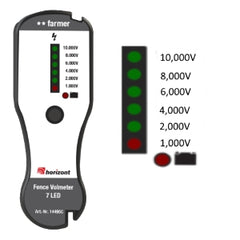You have no items in your shopping cart.
- Electric Netting
- Tape, Twine, Wire And Rope
- Fencing Energisers
- Fencing Posts
- Insulators
- Accessories
- Electric Fencing Kits
- Chicken Feeders and Drinkers
-
Information
- What is Electric Fencing
- Advantages of an Electric Fence
- Installing a Fence
- Is an Electric Fence a serious risk
- How to Erect a Net
- What you Need for a Fence
- Testing an Electric Fence
- Quantities Guide
- Improve Your Fence
- Poultry Netting Trial
- Electric Netting Dimensions
- Electric Fencing Mistakes
- TLD Max Technology
- Energiser Terminology
- Choosing an Energiser
- Fencing Articles
- Trouble Shooting
- Delivery Terms
- Frequently Asked Questions
- Here's a Blog Worth Reading
Testing an Electric Fence.
Testing, Testing... Why It's Important
When your electric fence is built, monitoring its voltage regularly on a daily basis is a basic management practice. All Electric Fencing systems are designed to use the ELECTRICITY in the fence as the deterrent - not the strength of the fence. If there is NO electricity then the fence is useless and will not fulfill its function.
Obviously a digital voltmeter that tells you exactly how many volts of current are on the fence is preferable but a simple LED tester that indicates a range of current is normally adequate for most situations. The only other way to test is to touch the wire yourself - that hurts.

Simple 10000v Tester.
It is possible to guestimate the energy by using a length of green grass just as it is possible to test a fence by touching the wire. The one method is very inaccurate whilst the second hurts likes crazy (as it is meant to)
Your first check of your new fence's voltage gives you a baseline so that future checks can alert you to voltage drops that signal problems. Depending on the strength of your charger, it will emit 6000 to 10,000 volts when nothing is connected to it. After you've hooked it to your fence, check the voltage at the furthest point from the charger. Some drop in voltage--1500 to 2000--is normal. A more than 2000-volt drop means either your charger is underpowered for the fence, vegetation or something else is "loading" the fence (touching it, causing voltage to leak away), there's a short-circuit somewhere in the system--or a combination of these. If the base voltage on your newly built fence is 5000 or better and everything's working fine, watch on subsequent checks for an overall voltage drop of 1500 or more. (It's normal for voltage to be 500-1000 lower in the morning when moisture on the fence, posts, and nearby vegetation can cause temporary current leakage.) Such a significant decrease means it's time to check for problems and correct them before your horse discovers the fence no longer packs a punch.
How many volts are enough? This is actually quite complex and there are several variables to consider. As a general rule these figures may be used as a guide:-
Horses, 5,000--remember, there's no way this jolt of current can hurt your horse, but it needs to be definite enough for him to remember it and want to avoid it.
Pigs, Quite easy really, 4-5000v
Sheep and Poultry. Have a natural insulation in feathers and wool - 7000volts
Dogs & Cats, 4000v
Wild Life. This really varies, Elephants 3500v to deer 7-8000v
The best solution is not to consider the animal and look to have in excess of 6000v in the fence at all times.








← Older Post Newer Post →
0 comments